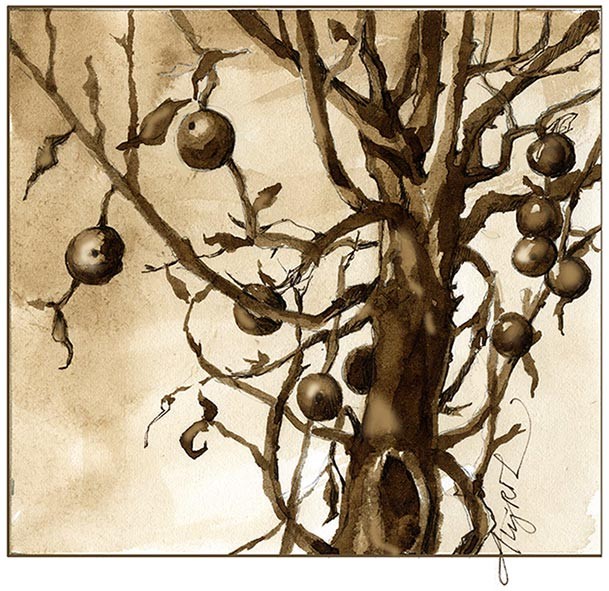
As Eve so famously discovered, apples are alluring. These brightly colored orbs tempt us with crisp flesh and juicy sweetness. It’s no wonder that apples have spread throughout the temperate regions of the world.
The mother of all apples, Malus sieversii, which originated in the rugged mountains of Central Asia, has given rise to thousands of varieties over time, bearing names ranging from regal to whimsical, including Maiden’s Blush, Blue Pearmain, Bellefleur, Duchess of Oldenburg, and Seek No Further. Apples first arrived in the Americas in the 1600s, and by the early nineteenth century were being grown to make everything from cider, sauce and pies to apple butter.
But the sprouts from apple seeds don’t breed true because they contain such a wide genetic variability. Grafting scionwood (fresh growth produced the previous year) onto a new rootstock, or onto an existing tree, is the only way to replicate a particular variety. When, as happens very rarely, a seed produces a new kind of desirable apple, this is known as a chance seedling. Delicious arose as a chance seedling from a Yellow Bellflower tree. An individual branch (a “sport”) on an existing tree will, again rarely, go off on a genetic tangent and produce a new kind of apple.
When colonial farmers discovered a new apple that was especially good for cider, baking, eating fresh, or storing, they grafted that scionwood, and a new variety was born. By the early 1800s, United States farmers were producing some 15,000 different kinds of apples — more varieties than in any other country.
With the advent of the twentieth century’s large-scale orchards, fewer varieties were planted and advertising came to define consumer preferences. Eighty percent of our “heirloom” apples stood on the brink of extinction. With the disappearance of each variety, we lost more of the apple’s rich heritage — the biological diversity that preserves pest-resistance, flavor, and other desirable traits. By 2011, of the top 20 varieties sold by total volume (204,564,000 bushels), more than 25 % were Red Delicious, over 16% Gala, 11% Golden Delicious, 9% Granny Smith, 9% Fuji, and around 5% McIntosh.
But all is not lost; many of the old varieties still hang on in the interstices of old fields and forests. These ancient trees, which once prospered in the orchards of small family farms and dooryards, are now being rediscovered.
Ezekiel Goodband, orchard manager at the Scott Farm in Dummerston, Vermont, is at the forefront of the heirloom apple movement. Goodband explained that, in the 1970s when he was living in Maine, he started finding old apple varieties in abandoned orchards. When he found orchards with blue apples and black apples — these were Blue Pearmains and Black Oxfords — he took cuttings and started a nursery. “Eventually, I brought my nursery stock with me to New Hampshire, and then to Vermont, where we now grow over 100 varieties.”
“When I found the old apples, and realized that thousands of varieties were no longer available,” he said, “it was like opening the door to a museum that had been shuttered for decades. Instead of paintings on a wall, there were varieties of apples.”
One does not have to be a lifelong orchardist to save heirloom apples. Whitman Brook Orchard in Quechee, Vermont grew out of Terry Dorman’s love for historic landscapes. In 1995 he acquired an orchard adjoining his property that was planted around 1924, but had been abandoned since the 1960s — half-dead Macintosh trees overwhelmed by forest growth during decades of neglect.
Some locals advised that it was too late to salvage the old trees, but he persevered. “You’ll look at the trunks of some of our old trees and you would say, ‘This can’t possibly be alive and certainly can’t bear fruit.’ Then you look up and see that they’re still growing. Before you automatically cut down a tree on your property, we show what you can do with it.”
From this beginning, Dorman added more than 100 heirloom varieties from farms and other sources. “We selected apples of local interest, or those that would appeal to our customers who pick them and to the stands we supply.” At the orchard, visitors have the opportunity to taste different heirloom apples and appreciate the traditional way they are grown.
Want to grow your own heirloom apples? “Spend a year or two trying heirloom apples out to decide which you like best,” advised Goodband. “Then order those kinds of trees from nurseries that specialize in heirloom varieties. You could also learn how to graft and add varieties to your trees.”
Goodband emphasized that benefits go beyond taste, to the preservation of our farming heritage. “When a variety of apple disappears, it’s like losing a sonata by Bach. Saving these apples is like having a masterpiece preserved.”
♦ ♦ ♦
Finding Heirloom Apples: A number of New England orchards now grow heirloom apples, including many listed on the this website.


Discussion *